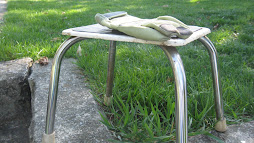
 Before I watered it, and then below is after...much better.
Before I watered it, and then below is after...much better.
Our friends, Judy and Duane gave us some Lamb's Ear (Latin Name: Stachys byzantina) and a ground cover called Woodruff (Latin Name: Galium odoratum). Both plants looked better than these pictures, after I gave them a good drink.
The Lamb's Ear like sun and I cannot resist 'petting' the leaves of the Lamb's Ear, which is quite soothing. Here is a bit of information about Lamb's Ear:
Information on Sweet Woodruff:
Sweet woodruff is considered a valuable herb in the garden. It's a perfect choice for those shady spots near trees and overhangs. It's also a natural insect repellent. Although a useful herb of longstanding, sweet woodruff gets short shrift because its greatest fame is derived from its historical addition to May wine or punch, often with Rhine wine and Champagne. As this use has become less widespread, sweet woodruff has become better known as a spring-blooming groundcover.
The light green leaves are tiny, thin and in star-like whorls around brittle stems that poke up only 4 to 5 inches above the soil. The delicate-looking leaves provide a welcome lightness and delicacy as a ground cover. The sprightly 1 inch diameter white flowers appear in great numbers, like a froth covering the plants in spring and last for a few weeks. Both the leaves and the flowers exude a soft, spicy scent that adds to the plant’s appeal. The fragrance is even more pronounced when the leaves and blossoms are dried for potpourris and sachets. Smelling of a mixture of sweet hay and cinnamon, particularly when dried, it has a number of household, aromatic, and medicinal uses.


No comments:
Post a Comment